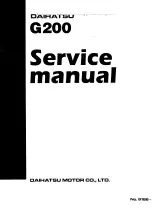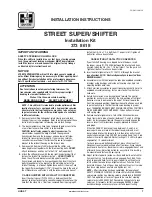
TIRE INFORMATION
D
Do
occ N
No
o::
21906540-RSAD
R
Re
ev
v::
00
C
Co
op
py
yrriig
gh
htt ©
© H
Ha
an
nm
ma
arr M
Mo
otto
orr C
Co
orrp
po
orra
attiio
on
n 2
20
00
05
5
H
H--1
1
Tire Fundamentals:
Federal law requires tire manufacturers to place
standardized information on the sidewall of all tires. This
information identifies and describes the fundamental
characteristics of the tire and also provides a tire
identification number for safety standard certification and in
case of a recall. See diagram H-P1 for an example.
P
The "P" indicates the tire is for passenger vehicles.
Next number
This three-digit number gives the width in millimeters of the
tire from sidewall edge to sidewall edge. In general the
larger the number, the wider the tire.
Next number
This two-digit number, known as the aspect ratio, gives the tire's ratio of height to width. Numbers of 70 or lower
indicate a short sidewall for improved steering response and better overall handling on dry pavement.
R
The "R" stands for radial. Radial ply construction of tires has been the industry standard for the past 20 years.
Next number
This two-digit number is the wheel or rim diameter in inches. If you change your wheel size, you will have to
purchase new tires to match the new wheel diameter.
Next number
This two- or three-digit number is the tire's load index. It is a measurement of how much weight each tire can
support. You may find this information in your owner's manual. If not, contact a local tire dealer. Note: You may not
find this information on all tires because it is not required by law.
M+S
The "M+S" or "M/S" indicates that the tire has some mud and snow capability. Most radial tires have these
markings; hence, they have some mud and snow capability.
Speed Rating
The speed rating denotes the speed at which a tire is designed to be driven for extended periods of time. The
ratings range from 99 miles per hour (mph)(Q) to 186 mph(Y or ZR). Note: You may not find this information on all
tires because it is not required by law.
U.S. DOT Tire Identification Number
This begins with the letters "DOT" and indicates that the tire meets all federal standards. The next two numbers or
letters are the plant code where it was manufactured, and the last four numbers represent the week and year the tire
was built. For example, the numbers 3197 means the 31st week of 1997. The other numbers are marketing codes
used at the manufacturer's discretion. This information is used to contact consumers if a tire defect requires a recall.
Picture H-P1:
Information on passenger vehicle tires
















































